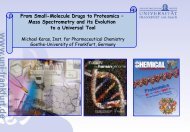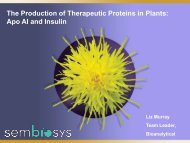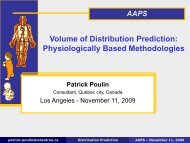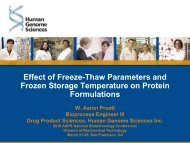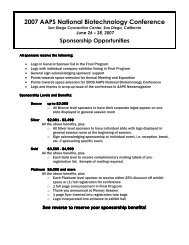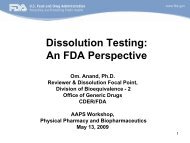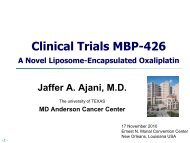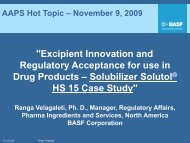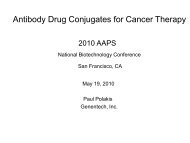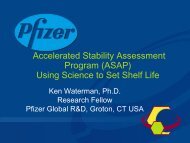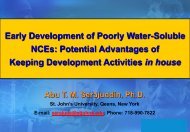Preliminary Program - American Association of Pharmaceutical ...
Preliminary Program - American Association of Pharmaceutical ...
Preliminary Program - American Association of Pharmaceutical ...
You also want an ePaper? Increase the reach of your titles
YUMPU automatically turns print PDFs into web optimized ePapers that Google loves.
SM<br />
67<br />
2009 AAPS Annual Meeting and Exposition<br />
AAPS Pharmacokinetics, Pharmacodynamics and Drug Metabolism (PPDM) <strong>Program</strong>ming<br />
<strong>Pharmaceutical</strong> R&D can benefit greatly from<br />
adopting important advances in discrete event<br />
M&S methods, which have occurred within the<br />
past decade. The time is ripe to begin exploring the<br />
insights that can be achieved using these methods;<br />
they provide capabilities beyond those <strong>of</strong> traditional<br />
analytical, inductive, equation-based PK and PD<br />
modeling and simulation (M&S) methods. These<br />
new M&S methods make it easier to instantiate<br />
increasingly realistic, multi-level, multi-scale, multiattribute,<br />
adaptable, and extensible models relevant<br />
to pharmaceutical R&D. The models are suitable for<br />
use in research and in testing hypotheses about the<br />
pharmacological and toxicological mechanisms that<br />
are relevant to pharmaceutical R&D. This symposium<br />
will provide the audience an overview <strong>of</strong> these<br />
new methods. Presentations will draw on specific,<br />
pharmaceutically relevant models. Because the<br />
new methods are intended to be synergistic<br />
with traditional PK/PD M&S methods, the new<br />
and traditional methods will be compared<br />
and contrasted.<br />
Moderator<br />
Steven Chang, M.S.<br />
Immunetrics Inc.<br />
Dynamic Knowledge Representation Using an<br />
Agent-based Modeling Paradigm<br />
Gary An, M.D.<br />
Northwestern University<br />
Measuring, Modeling, and Modulating<br />
Inflammation in Mice and Men<br />
Yoram Vodovotz, Ph.D.<br />
University <strong>of</strong> Pittsburgh<br />
Bridging the Gap Between Mathematical<br />
Models and Wet-lab Models<br />
C. Anthony Hunt, Ph.D.<br />
University <strong>of</strong> California San Francisco<br />
Using Agent-directed Simulation to Accelerate<br />
Unraveling the Complexities <strong>of</strong> Adaptive<br />
Biological Systems<br />
Levent Yilmaz, Ph.D.<br />
Auburn University<br />
Tuesday, November 10, 2009<br />
TUESDAY SUNRISE SESSIONS<br />
7:00 am – 8:15 am<br />
The Blood Brain Barrier<br />
Sunrise Session<br />
Pharmacokinetic assessment in early drug discovery<br />
is now a commonly accepted approach to increase<br />
the chances <strong>of</strong> identifying candidates with suitable<br />
properties for further development. For CNS<br />
therapeutics, there is the additional requirement<br />
<strong>of</strong> blood brain barrier (BBB) penetration and brain<br />
localization. Several tools, both old and new, are<br />
being applied to guide drug design and medicinal<br />
chemistry to increase brain penetration. This<br />
sunrise session will contain presentations about<br />
in silico prediction tools for BBB, discuss in vitro<br />
models <strong>of</strong> the BBB, and present a case study <strong>of</strong> BBB<br />
enhancements in drug discovery.<br />
Moderator<br />
Nurulain Zaveri, Ph.D.<br />
Molecular Medicine Research Institute<br />
Key Principles for Optimization <strong>of</strong> CNStargeted<br />
Therapeutics<br />
Stephen Hitchcock, Ph.D.<br />
Amgen Inc.<br />
Presentation Title to be Determined<br />
Andrew Coop, Ph.D.<br />
University <strong>of</strong> Maryland School <strong>of</strong> Pharmacy<br />
7:00 am – 8:15 am<br />
The Story <strong>of</strong> the Three Bears: Too Big,<br />
Too Small, Just Right! Size Issues in Drug<br />
Development<br />
Sunrise Session<br />
Determining the most appropriate dose for a new<br />
pharmaceutical one must take into account two<br />
different perspectives the patient and the drug.<br />
Patients come in a variety <strong>of</strong> sizes and drugs vary<br />
in their therapeutic range, and the necessity to<br />
customize the dose for individual patients. Healthy<br />
volunteers participating in phase 1 studies are<br />
usually within 15% <strong>of</strong> ideal body weight. Subjects<br />
participating in phase 2 and 3 trials are also<br />
usually within a reasonably narrow range <strong>of</strong> weight,<br />
compared to the people who will eventually be<br />
treated including premature neonates (0.5kg) to the<br />
very obese (200 kg+). How can adequate information<br />
be collected during drug development on the best<br />
way to dose patients who are either much smaller<br />
than average, or much larger than average to avoid<br />
increased incidence <strong>of</strong> adverse events or inadequate<br />
treatment? Some medications are prescribed in<br />
‘flat’ doses expressed in mg for example, while<br />
others are dosed on a mg/m2 or mg/kg basis.<br />
When is it appropriate to do either? Biologics have<br />
conventionally been doses by weight, as have drugs<br />
used to treat cancer, yet in some cases, normalizing<br />
for size increases variability and potential for<br />
dose administration error. What factors should be<br />
considered in developing dosing recommendations?<br />
At the end <strong>of</strong> the session participants will be able<br />
to describe the different ways that size is described<br />
(ideal body weight, actual body weight, lean body<br />
weight, fat free mass, dry weight, body surface area,<br />
body mass index, growth charts), list the data/<br />
conventions upon which dosing per kg and dosing<br />
per m2 is based, become familiar with study design<br />
and analysis methods to determine if dosing needs<br />
to be adjusted for size, and describe the potential<br />
impact <strong>of</strong> over and underdosing on patient outcome.<br />
Moderator<br />
Joan M. Korth-Bradley, Pharm.D., Ph.D., R.Ph.<br />
Wyeth Research<br />
How Big? How Small? Methods and<br />
Conventions <strong>of</strong> Describing Size<br />
Joan M. Korth-Bradley, Pharm.D., Ph.D., R.Ph.<br />
Wyeth Research<br />
Size is Not Everything — Life Beyond Allometry<br />
Nick Holford, M.D., M.S.<br />
University <strong>of</strong> Auckland<br />
AAPS Graduate Student Symposia<br />
and Research Achievement Awards<br />
8:30 am – 11:00 am<br />
AAPS Graduate Student Symposium in<br />
Pharmacokinetics, Pharmacodynamics<br />
and Drug Metabolism and Clinical<br />
Pharmacology and Translational<br />
Research (PPDM & CPTR)<br />
Sponsored by<br />
During this Symposium, a presentation from the Research<br />
Achievement Award winner will be given.<br />
AAPS Research Achievement Award in Clinical<br />
Pharmacology and Translational Research<br />
Sponsored by



